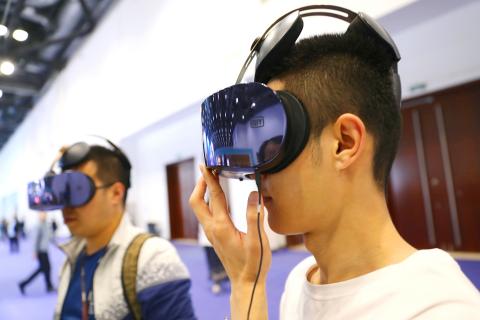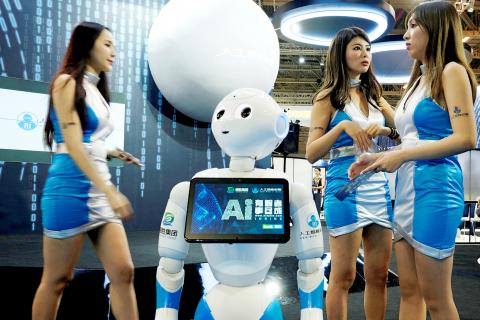The first half of Lifestyle of the Richard and Family is all too familiar theatrical content: the unhappy couple; the disaffected teenager; the dinner party; the secrets; the affair. The characters and beats come from a kind of theater that steadfastly refuses to go out of style, no matter how stale it is.
But something is strange about the words coming from these mouths on stage. The sentences, while technically complete, veer off on weird tangents. There is no witty dialogue here; if the lines are funny it is because of their nonsense. But playwright Roslyn Helper can be forgiven.
She wrote the play with the help of artificial intelligence.

Photo: EPA-EFE
Artificial intelligence (AI) is a specter that haunts the modern workforce. Some studies suggest up to 30 percent of people could lose their jobs to it. Driverless vehicles could see the end of truck drivers, robots could increasingly take over even complex manufacturing, personal assistants and customer support workers may be made redundant. Robots look set to judge gymnastics. Not content with the three options provided in reply e-mails in Gmail, Google will now even write a whole e-mail for you.
So if AI is the way of the future, is it the way of theater?
Lifestyle, a play presented by Next Wave festival and Melbourne Knowledge Week, suggests not. The “artificial” of AI sits heavily on the work; it’s amusing for its glitches rather than its sense. But as AI encroaches on our day to day lives, it will increasingly make its way into the art world. So how will it be used? And what does it mean for how we understand art?

Photo: REUTERS
MALE BIAS
AI is a learning system. To create AI artists, humans will need to select the information the system learns from. So while AI is nominally intelligent and separate from humans, its algorithms are built through the lens of human bias. We are currently seeing a distinct white male bias in AI. Not surprisingly, the history of western theater is also one of white male bias.
Lifestyle isn’t the only work in Next Wave to be thinking about this robot future. Bureau of Meteoranxiety is an installation piece acting as satire on contemporary mindfulness and self-care, and our disconnection from nature and fears about climate change. As part of the work, you are invited to talk with an AI chatbot, Gail, about your weather-based anxieties.
While she often seems to answer a question that is slightly different from the one you actually asked, there is something strangely comforting about this discussion of weather. Yet Gail’s female name (most chatbots, in a position of subservience, have female names ) hides the male influences that have gone into her. In my discussion with her she quotes (uncredited) the work of male poets and then, gallingly, Donald Trump.
By using AI in this artistic context, the artists encourage us to view the technology through a critical lens. The Bureau, and Gail, feel like services people might very much want to use, but if we did, whose biases would we be fed? For that matter, whose biases exist in the AI we increasingly use? If AI becomes the artist, how will we know to look at who created the AI? Who is the creator’s creator?
Singularity, part of Melbourne Knowledge Week, had perhaps the most pessimistic view of an AI future. Imagining an Australia in 2040, when most people dine alone, the audience was segregated into single eating booths and served by robots fulfilling “all of [our] nutritional and emotional needs.” In fact, large wooden boxes hid the artists sitting inside these moving robots, feeding a person at one table a gray cube of jelly while serving the person sitting next to them an inscrutable progression of images via screens.
But if this future was supposed to be an allegory for how robots will make our lives dull, it fell down at the first hurdle, as I watched audience members during the performance pull out their phones to amuse themselves. The technology of today has long surpassed the imagined technology of tomorrow.
Perhaps AI art is only as interesting insofar as you know what has gone into its creation. Little is said about how SwiftKey, the AI that co-wrote Lifestyle, was specifically used, but the strange beginning of the work pays off when Helper and director Harriet Giles break out of the mold of traditional theater: the cast dance; screens show us the predictive text used to write the work; the world dissolves further and further into the creative imagination of performance — which can only ever be truly realized through human collaboration.
Next Wave has long held the edict of asking artists to be as ambitious as possible, so it is only natural that the artists of today, in their ambition, ask what AI can do for them. For the moment, the artists seem to be coming out on top.

This month the government ordered a one-year block of Xiaohongshu (小紅書) or Rednote, a Chinese social media platform with more than 3 million users in Taiwan. The government pointed to widespread fraud activity on the platform, along with cybersecurity failures. Officials said that they had reached out to the company and asked it to change. However, they received no response. The pro-China parties, the Chinese Nationalist Party (KMT) and Taiwan People’s Party (TPP), immediately swung into action, denouncing the ban as an attack on free speech. This “free speech” claim was then echoed by the People’s Republic of China (PRC),

Exceptions to the rule are sometimes revealing. For a brief few years, there was an emerging ideological split between the Democratic Progressive Party (DPP) and Chinese Nationalist Party (KMT) that appeared to be pushing the DPP in a direction that would be considered more liberal, and the KMT more conservative. In the previous column, “The KMT-DPP’s bureaucrat-led developmental state” (Dec. 11, page 12), we examined how Taiwan’s democratic system developed, and how both the two main parties largely accepted a similar consensus on how Taiwan should be run domestically and did not split along the left-right lines more familiar in

Specialty sandwiches loaded with the contents of an entire charcuterie board, overflowing with sauces, creams and all manner of creative add-ons, is perhaps one of the biggest global food trends of this year. From London to New York, lines form down the block for mortadella, burrata, pistachio and more stuffed between slices of fresh sourdough, rye or focaccia. To try the trend in Taipei, Munchies Mafia is for sure the spot — could this be the best sandwich in town? Carlos from Spain and Sergio from Mexico opened this spot just seven months ago. The two met working in the

Many people in Taiwan first learned about universal basic income (UBI) — the idea that the government should provide regular, no-strings-attached payments to each citizen — in 2019. While seeking the Democratic nomination for the 2020 US presidential election, Andrew Yang, a politician of Taiwanese descent, said that, if elected, he’d institute a UBI of US$1,000 per month to “get the economic boot off of people’s throats, allowing them to lift their heads up, breathe, and get excited for the future.” His campaign petered out, but the concept of UBI hasn’t gone away. Throughout the industrialized world, there are fears that